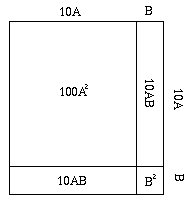square root
(algorithm)Definition: This describes a "long hand" or manual method of calculating or extracting square roots. Calculation of a square root by hand is a little like long-hand division.
Suppose you need to find the square root of 66564. Set up a "division" with the number under the radical. Mark off pairs of digits, starting from the decimal point and working left. (Here the decimal point is a period (.) and commas (,) mark pairs of digits.)
___________
\/ 6,65,64.
Look at the leftmost digit(s) (6 in this case). What is the largest
number whose square is less than or equal to it? It is 2, whose square
is 4. Write 2 above, write the square below and subtract. __2________
\/ 6,65,64.
-4
----
2
Now bring down the next two digits (65). The next "divisor" is double
the number on top (2x2=4) and some other digit in the units position
(4_). __2________
\/ 6,65,64.
-4
-----
4_ ) 265
What is the largest number that we can put in the units and multiply
times the divisor and still be less than or equal to what we have?
(Algebraically, what is d such that d × 40+d ≤ 265?) It looks like 6
might work (since 6 × 40 = 240), but 6 is too big, since 6 × 46 = 276: __2__6_____
\/ 6,65,64.
-4
-----
46 ) 265
-276 TOO BIG
So try 5 instead. __2__5_____
\/ 6,65,64.
-4
-----
45 ) 265
-225
-------
40
Repeat: bring down the next two digits, and double the number on top (2 × 25 = 50) to make a "divisor", with another unit. __2__5_____
\/ 6,65,64.
-4
-----
45 ) 265
-225
-------
50_ ) 4064
It looks like 8 would work. Let's see. __2__5__8__
\/ 6,65,64.
-4
-----
45 ) 265
-225
-------
508 ) 4064
-4064
------
0
So the square root of 66564 is 258. You can continue for as many
decimal places as you need: just bring down more pairs of zeros. Here is an example spanning the decimal point. When a number does not have a rational square root, you can continue calculating (significant) digits as long as you wish.
__1__6.8_4_0_4_2_7_5_...
\/ 2,83.6
-1
-----
26 ) 183
-156
------
328 ) 2760
-2624
-------
3364 ) 13600
-13456
--------
33680 ) 14400
-0
---------
336804 ) 1440000
-1347216
----------
3368082 ) 9278400
-6736164
-----------
33680847 ) 254223600
-235765929
------------
336808545 ) 1845767100
-1684042725
-----------
161724375
Why does this work? Consider (10A + B)² = 100A² + 2 × 10AB + B² and think about finding the area of a square. Remember that 10A + B is just the numeral with B in the units place and A in the higher position. For 42, A=4 and B=2, so 10 × 4 + 2 = 42.

The area of the two skinny rectangles is 2 × 10A × B. The tiny square is B². If we know A and the area of the square, S, what B should we choose?
We previously subtracted A² from S. To scale to 100A², we bring down two more digits (a factor of 100) of the size of S. We write down twice A (2A), but shifted one place to leave room for B (10 × 2A or 2 × 10A). Now we add B to get 2 × 10A + B. Multiplying by B gives us 2 × 10AB + B². When we subtract that from the remainder (remember we already subtracted A²), we have subtracted exactly (10A + B)². That is, we have improved our knowledge of the square root by one digit, B.
We take whatever remains, scale again by 100, by bringing down two more digits, and repeat the process.
square root of 3 by division method
Source :-http://xlinux.nist.gov

No comments:
Post a Comment